Essential Guide to Feeding Birds for Avian Health
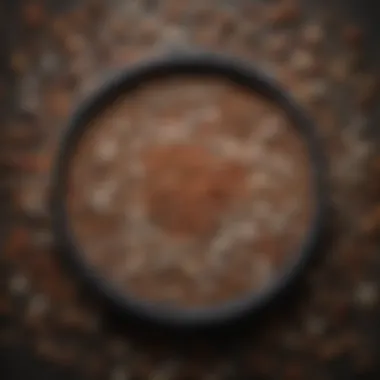
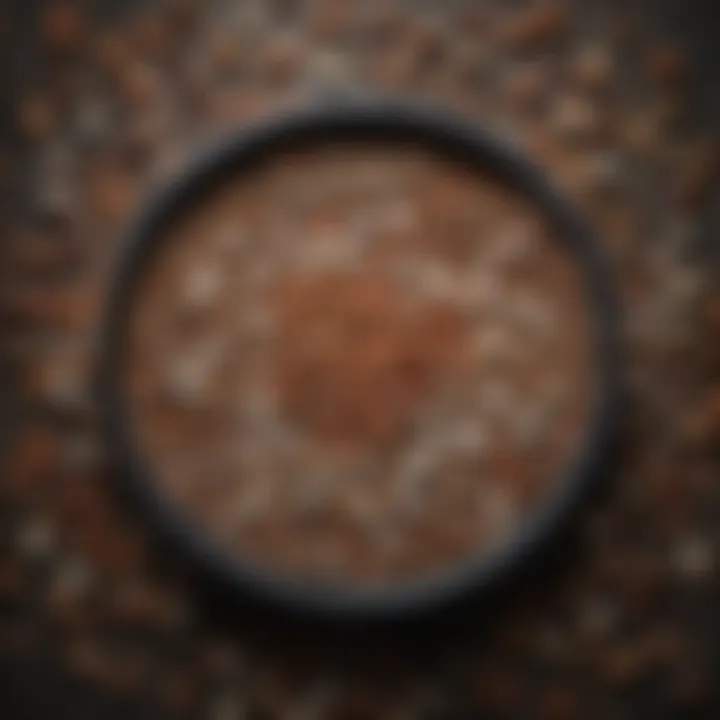
Intro
Birdwatching has grown in popularity among those who seek a deeper connection with nature. Knowing what to feed birds not only provides them sustenance but also elevates one’s backyard into a haven for these beautiful creatures. The natural diet of birds varies enormously, influenced by their species, habitat, and even the time of year. While this guide aims to clear the fog surrounding avian diets, it also underscores the importance of responsible feeding practices that do not interfere with nature’s balance.
The Importance of Proper Bird Feeding
Attracting birds to your garden or yard isn’t just about a colorful feeder hanging from a tree. It’s about understanding what these birds need throughout their life cycle. Proper feeding supports their health, increases reproduction rates, and enhances diversity in local ecosystems. Also, avian food plays a role in their behavior; a well-fed bird feels more secure and is less likely to stray too far from its safe zone.
"Understanding the needs of birds and providing for them responsibly can foster a beautiful coexistence between humans and wildlife."
Consequently, this guide is a call to action: to learn about bird nutrition and to apply that knowledge effectively. Together, we can create a welcoming environment for our feathered friends while contributing to the overall health of their populations. By taking small, deliberate steps, we help paint a broader picture that captures the interaction between humans and birds in perfect harmony.
Design Inspirations
Creating a bird-friendly garden or feeding station not only serves the needs of the birds but can also be an aesthetically pleasing part of your home design. Just as the right color palettes can transform a living space, the correct design choices can make your garden a magnet for birds.
Natural Aesthetics
Utilizing natural materials in bird feeders or baths can attract your avian visitors while complementing your garden’s surrounding landscape. Here are some ideas:
- Wooden Feeders: Durable and often handcrafted, they blend seamlessly into a garden setting.
- Stone Bird Baths: These add a rustic touch and provide birds with a place to bathe and drink.
- Native Plants: Incorporating plants that naturally attract birds can enhance your garden’s design and provide natural food sources.
Eco-Friendly Options
Bird feeding doesn’t have to be flashy; simplicity can be striking. Here are a few designs that resonate with a softer, environmentally conscious aesthetic:
- Recycled Materials: Feeders made from re-purposed plastic bottles or tins can serve dual purpose – eco-friendliness and functionality.
- Hanging Gardens: Using vertical space by planting tubes or hanging planters can attract species that prefer places high off the ground.
- Seasonal Decorations: Rotate your feeder decor with the seasons which not only keeps it fresh but also celebrates the changing environment.
Understanding Bird Nutrition
Understanding bird nutrition is pivotal for ensuring that our feathered friends thrive in their environments. Just like humans, birds require a balanced diet to maintain their health. This section is all about breaking down the essential elements that comprise a proper avian diet, shedding light on how specific foods can fulfill their dietary requirements.
Not all birds are made the same. The nutritional needs can vary significantly between species. Whether you're fostering a parakeet in your living room or admiring a wild blue jay in the park, knowing what they digest well can make a world of difference. When we attend to bird nutrition, we not only improve their well-being but also contribute to the local ecosystem.
The Science of Bird Diets
Bird diets are not a one-size-fits-all matter. They are influenced by various factors, including habitat, evolutionary adaptations, and the availability of food sources. Some birds are seed eaters, others thrive on insects, while some require a mix of both along with fruits and nuts.
To understand bird diets, we must look at their anatomy. The shape of a bird's beak and their digestive system are tailored to their specific dietary needs. For instance, seed-eating birds often have strong, conical beaks for cracking open seeds, while nectar-feeders possess long, slender beaks that allow them to reach deep inside flowers. This specialization not only ensures their survival but also plays a vital role in pollination and seed dispersal, further enriching their ecosystems.
Macronutrients Essential for Birds
Fats
Fats provide an energy punch for birds. In colder months, high-fat foods, like nuts and seeds, become crucial as they help birds generate the warmth necessary for survival. The key characteristic of fats lies in their ability to supply energy quickly, especially needed during strenuous activities like migration. They are particularly beneficial in winter when food is scarce. On the side, it is essential to not overdo it, as too much fat can lead to obesity in birds.
Proteins
Proteins serve as the building blocks of life for birds, playing an indispensable role in growth and feather development. Young birds require ample protein as they molt and grow. A key trait of proteins is their role in the synthesis of enzymes and hormones. Therefore, offering proper protein-rich foods, such as mealworms or high-quality pellets, is non-negotiable. However, it’s wise to balance protein intake; excessive protein can lead to health problems.
Carbohydrates
Carbohydrates are vital for providing energy, particularly for active birds. Foods like grains or fruits fulfill these energy needs efficiently. Their noteworthy feature is how they can boost quick energy levels, necessary for fleeting activities like escaping predators. However, moderation is crucial, as too many carbohydrates can create spikes in energy levels and related metabolic issues.
Vitamins and Minerals for Avian Health
Vitamins and minerals are critical for birds to achieve optimal health. While macronutrients serve as the main energy sources, micronutrients help in various bodily functions, including immune system strength, feather quality, and overall vitality.
Vitamin A
Vitamin A plays a crucial role in vision, growth, and reproduction for birds. It is essential for maintaining a robust immune system as well. The distinct characteristic of vitamin A in birds is its role in promoting good eyesight, especially in dim conditions. Ensuring birds have access to this vitamin through vegetables and fruits is vital, but beware of excess, which can lead to toxicity.
Calcium
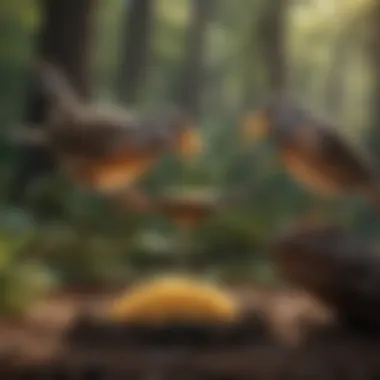
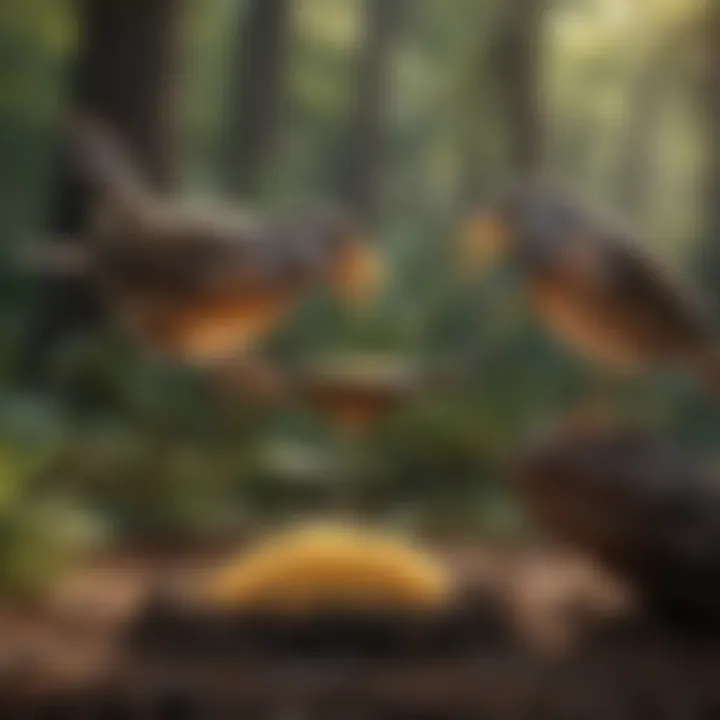
A strong skeletal structure is fundamental to bird health, and calcium is the backbone of this requirement. This mineral is particularly important for breeding females, where calcium fortifies eggshells. What makes calcium unique is its direct impact on growth and the ability to reduce the risk of fractures. Enriching their diet with calcium sources like crushed oyster shells or leafy greens is a straightforward way to achieve this goal, although over-supplementation can be harmful.
Zinc
Zinc is less talked about but no less important. It supports overall metabolism and contributes to the healing process. A defining characteristic of zinc is its role in enzymatic reactions, which are vital for energy production. Offering seeds and whole grains ensures that birds get an adequate supply of zinc. Nonetheless, too much can lead to toxicity, necessitating a balanced approach.
The right mix of nutrients caters to the well-being of birds, and understanding these essential components can foster a supportive environment for them.
In summary, comprehending bird nutrition narrows down to key macronutrients and micronutrients. We will discuss specific types of bird food next, diving deeper into practical ways to cater to their varied needs.
Types of Bird Food
Understanding the various types of bird food is fundamental for anyone eager to support the avian visitors in their garden or balcony. Different birds have specific dietary preferences that directly affect their health and behavior. Providing the right food not only helps them thrive but also encourages a wider variety of species to visit your space, enhancing the experience of birdwatching. This section delves into the popular categories of bird food, offering insights on their benefits and considerations.
Natural Food Sources for Birds
Understanding what birds naturally consume is essential for creating a harmonious environment that supports their well-being. Natural food sources not only fulfill the nutritional requirements of various bird species but also promote their health and longevity. When we provide food that aligns with their instinctual diets, we foster a connection to nature that breeds coexistence rather than competition. This section delves into two main components of natural food sources: insects and plants, including berries.
Insects: A Key Nutritional Element
Birds are innately inclined to capture and consume insects. This is crucial not just for adult birds, but especially for growing chicks that require a diet rich in proteins and fats. Insects serve as a primary food source for many species, helping to develop strong muscles and feathers.
Worms
Worms are an important part of the natural diet of many birds. These critters play a significant role in the ecosystem by aerating the soil and decomposing organic matter. They are particularly advantageous because they are rich in protein, which helps with the growth and maintenance of body tissues in birds. A key characteristic of worms is their availability throughout various seasons, making them a reliable food source. Their unique feature is that they are easy to digest, making them a favored choice for nestlings or birds recovering from illness. However, one should keep in mind that sourcing live worms must be done sustainably to avoid over-extraction and ecological imbalance.
Caterpillars
Caterpillars, the larval stage of moths and butterflies, are another protein-packed delicacy that birds find irresistible. These soft-bodied insects are not only plentiful during specific seasons but also deliver vital nutrients necessary for growth. The presence of caterpillars can attract a variety of birds, ranging from songbirds to larger species. A noteworthy aspect of caterpillars is their ease of foraging; they tend to be slow-moving, making them easier for birds to catch. Nevertheless, caterpillars may occasionally carry pesticides, so it's wise to be cautious about the source before offering them.
Beetles
When it comes to nutrition, beetles can be a powerhouse as they are rich in essential fatty acids. Their hard exoskeletons make them a bit tougher when it comes to digestion; however, many birds have adapted to preen them down before consumption. A beneficial characteristic of beetles is their ability to thrive in various environments, creating consistent opportunities for birds to forage. The downside is that not all beetles are edible; some can be toxic, so identifying safe species is crucial for successful feeding.
Plants and Berries
Not only do birds benefit from insects, but they also rely heavily on plant materials, including fruits and seeds. These natural foods not only provide birds with necessary calories but also other essential nutrients like vitamins and minerals.
Bramble Berries
Bramble berries, such as blackberries and raspberries, are highly sought after by many avian species. Their naturally sweet taste makes them an attractive food source during the berry season. Bramble berries are also beneficial because they provide antioxidants and vitamins that aid in birds' overall health. One unique feature is their thorny structure, which can deter larger predators, allowing smaller birds a safe space to feed. However, these bushes can be challenging to navigate and might not suit all birds.
Herb Seeds
Seeds from various herbs, including dill, basil, and parsley, are nutritious and often overlooked options for birds. They contain a mix of healthy oils and flavor enhancers that can attract a wide range of species. A key trait of herb seeds is their small size, making them easy for smaller birds to consume. However, some herb seeds may not provide as balanced a diet compared to other food sources, requiring a mix with more substantial offerings.
Native Flowers
Native flowers provide essential nectar and seeds that support local bird populations. By integrating native plants into gardens or landscapes, homeowners can create a sustainable environment for birds. A major advantage is that these plants are well-adapted to local climates, requiring less care and attracting a diverse array of birds. However, some native flowers may not produce seeds quickly enough for birds during peak seasons, necessitating a mind towards planting and blooming schedules.
In summary, understanding natural food sources for birds is vital for anyone keen on creating a supportive habitat. Whether through insects, berries, or plants, each food source plays a specific role in enhancing avian health and promoting ecological balance.
Feeding Methods and Techniques
Feeding birds is not just a casual pastime; it’s a blend of science, art, and a touch of nature. The methods and techniques you choose significantly affect how successful you’ll be at attracting and nourishing these feathered friends. Understanding the various feeder types along with their best placement can influence bird behavior and species variety. As birdfeeders, one aims to create an environment that mimics the natural feeding habits of birds while ensuring their safety and well-being.
Feeder Types and Their Benefits
Tube Feeders
Tube feeders are an interesting choice for many bird enthusiasts. They are crafted in a cylindrical shape, generally made of clear plastic or glass. This design allows for easy viewing of seed levels, which is practical for maintaining a supply. One of the standout features is the small feeding ports that help minimize seed spillage and reduce waste. Some birds, particularly finches and chickadees, are more inclined to use these feeders due to their design.
However, tube feeders may not cater to larger birds like jays. Since they have specific access ports, bigger birds could find it tricky to partake in the offered seeds. Still, their benefits often outweigh shortcomings, making them a favored option in many gardens.
Hopper Feeders
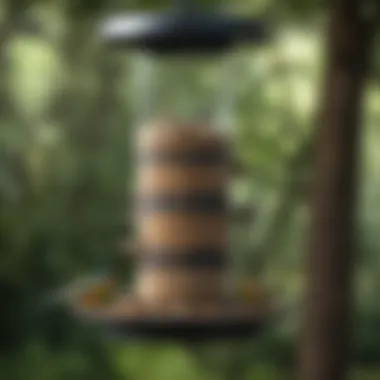
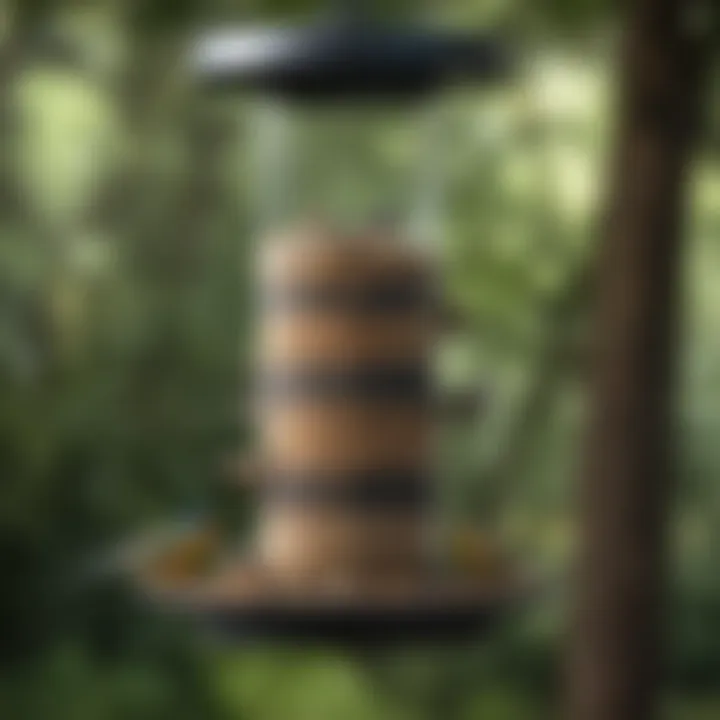
Hopper feeders operate like miniature silos. They have a wide base that holds a sizeable amount of seed, and they dispense it over time through feeding holes. A key advantage of this style is that they attract a wider variety of birds due to their large size. Cardinals, sparrows, and even woodpeckers may frequent these feeders, all drawn in by the abundance of seed.
Additionally, the design protects seeds from some weather elements, keeping them dry. Nonetheless, the downside is that hopper feeders can become heavy, making them cumbersome to clean. The challenge is ensuring that moldy seeds do not build up, which could harm birds. Proper management is essential for their use.
Platform Feeders
Platform feeders resemble small bird tables. They provide an open area for birds to gather, feeding on seeds, fruits, or even nuts. The major draw of platform feeders is their accessibility; birds of all sizes, from cardinals to sparrows, can easily single out their food. These feeders can cover a wide variety of offerings, engaging different species effectively.
But, this open design also brings challenges. It exposes food to elements like rain or snow, potentially spoiling it quickly. Moreover, their design might attract unwanted visitors, like squirrels and other critters looking for a free meal. Balancing the pros and cons is key when selecting these feeders.
Strategic Placement of Feeders
Near Cover
Placing feeders near natural cover—like trees or shrubs—helps birds feel secure. This strategy acknowledges the instinctual need of birds to have safe spots. When feeders are too exposed, it can raise their anxiety levels, making them less likely to visit. The cover allows birds to make quick escapes from potential predators, as they can dart behind branches or foliage.
However, it's essential to find a balance. If feeders are too close to dense brush, it might hinder access for birds. A foot or two of spacing can provide safety while still making the feeders easily accessible.
Visibility and Access
For a successful feeding station, finding the sweet spot for visibility and access is crucial. Feeders should be easy to see from a distance, not only for the birds but also for you as the observer. Positioning them in open areas where birds can spot them can aid in attracting a variety of species. Take into account the lines of sight from your house or patio to maximize enjoyment.
On the flip side, while visibility is great for attracting birds, accessibility should not be overlooked. You want to make sure that they are positioned where you can access and clean them with ease, preventing any struggles as you maintain your feeding setup.
Avoiding Predators
Ensuring that feeders are out of reach from common predators is a fundamental aspect of bird feeding. Cats, raccoons, and even some birds of prey can see feeders as easy targets. One effective way to deter predators is to install feeders at least five feet off the ground and away from potential perches, like tree branches. The goal is to create a sanctuary where birds feel safe to roam and feed without the constant worry of being hunted.
Considerations for Seasonal Feeding
Understanding how to feed birds effectively throughout the seasons is crucial for their survival and well-being. Just as humans adapt their diets to meet their climate demands, so too do birds require different nutritional supports depending on the time of year. Seasonal feeding addresses several vital aspects, including dietary adjustments, food availability, and hydration needs. Each season presents unique challenges and opportunities for backyard bird enthusiasts.
During the colder months, there's a pressing need for high-energy foods. In contrast, summer often brings a bounty of natural resources which might influence the level of artificial feeding you might consider. Thus, being mindful of these shifts ensures that your feeding practices remain beneficial and sustainable.
Winter Feeding Strategies
High-Calorie Offerings
In winter, food sources become scarce as natural vegetation fades, making high-calorie offerings essential. Foods like suet, peanuts, and high-oil seeds emerge as popular choices among bird watchers for good reason. These high-calorie foods help birds maintain their energy levels amid the cold. A key characteristic of these offerings is their ability to deliver rapid energy, crucial for birds that expend significant energy keeping warm or foraging in the snow.
One unique feature of high-calorie offerings is their capacity to attract a diverse range of bird species, from woodpeckers to chickadees. This characteristic not only benefits the birds but also enhances the feeding experience for observers. However, care must be taken. Over-reliance on these foods can lead to dependency, complicating natural foraging instincts.
Water Supply
Providing a consistent water supply is just as essential as solid food offerings during winter. Many bird species struggle to find open water sources when temperatures plummet. A key characteristic of a good water supply is its ability to remain unfrozen, whether through heated bird baths or regular maintenance.
This aspect is beneficial, as it supports not only drinking needs but also helps birds keep their feathers in top condition, aiding in insulation. Additionally, having a water supply can attract more birds to your yard, enhancing the vitality of your feeding stations. The challenge, however, is ensuring the water remains clean and free from ice.
Summer Feeding Practices
Natural Food Availability
With the arrival of spring and summer, natural food sources for birds flourish. Insects, berries, and seeds become abundant, so understanding natural food availability is paramount. The key characteristic of this availability is that it nurtures ideal diets for breeding and chick-rearing. Bird parents often shift their feeding habits to take advantage of these seasonal offerings, which means your artificial sources can supplement rather than completely replace a bird’s diet.
One unique feature of natural food availability is its variability based on locality and climate. Gardens filled with native plants effectively encourage local birds to forage naturally, therefore reducing their dependence on feeders. However, neglecting artificial feeding during peak times can limit the options for adult birds and their chicks, particularly in urban settings.
Hydration Strategies
Hydration strategies are incredibly important as summer temperatures soar. Even though water is often more readily available during this season, offering supplemental hydration in the right manner is beneficial. This can include adding clean bird baths that birds can easily access and stay cool in.
The key characteristic of hydration strategies is maintaining water clean and free from algae. As birds come to bathe and drink, ensuring water supplies are refreshed daily can attract more avian visitors. A unique feature of hydration strategies lies in their dual purpose; not only do they quench thirst, but they can also provide birds with a refreshing respite from the heat.
In sum, being aware of these seasonal considerations ensures that your bird feeding practices support avian health while fostering their natural behaviors. Adjusting food types, providing consistent hydration, and promoting natural foraging opportunities create a tailored feeding environment that many birds will appreciate.
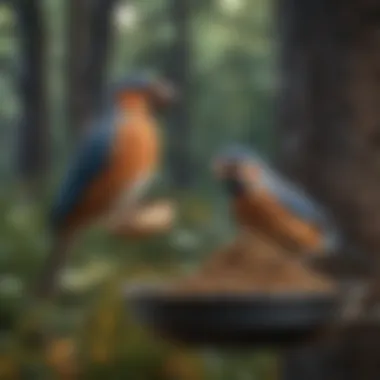
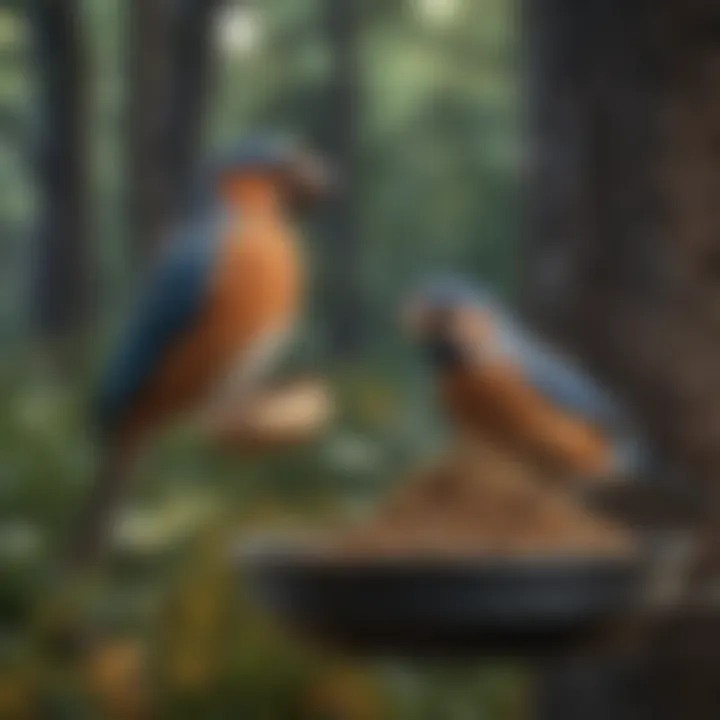
"The delicate balance of nature requires each of us to contribute in thoughtful ways, especially when feeding birds during the various seasons."
Keeping seasonality in mind is a crucial step in maintaining a vibrant bird population that thrives in your garden.
Ethical Considerations in Bird Feeding
Bird feeding can seem like a heartwarming activity, but it’s not all sunshine and rainbows. The choices we make when feeding birds can have lasting effects on their behavior and overall health. In this section, we will peel back the layers of ethical considerations in bird feeding, addressing the impact of human feeding on bird behavior and highlighting harmful foods to steer clear of.
Impact of Human Feeding on Bird Behavior
When we introduce food into a bird's environment, it’s essential to understand how this can change their natural habits.
Dependency Risks
One of the most pressing concerns is the risk of dependency. Birds that frequently rely on human-provided food can lose their instinct to forage. This dependency turns them from independent creatures into beggars, which is not around healthy at all. The key characteristic here is that while feeding birds seems like an act of kindness, it could eventually backfire by making them less capable in their natural routines.
The unique feature of this dependency is that it can lead to inconsistency in food sources. For example, if your bird feeder isn't refilled regularly, birds accustomed to relying on it can struggle. By paying close attention to how often you feed, you can balance this and promote natural foraging behaviors while still offering them nutritious options.
Altered Migration Patterns
Another crucial aspect is altered migration patterns. When food is readily available, birds might choose to stick around rather than migrating. This behavior can disrupt their natural life cycle.
The key characteristic of this phenomenon is that it can cause long-term issues in populations, as some species rely on semiannual migrations for climate and resource benefits. By allowing birds to adapt to a stable food source in one location, we potentially leave them vulnerable during times when they’d typically migrate for better conditions.
The unique feature of altering migration patterns is that it not only affects individual birds but entire species. As migration routes shift, birds may face unexpected challenges, like habitat loss or increased competition, making this a highly relevant point in our discussions on bird feeding.
Avoiding Harmful Foods
Intentionally providing the right food is just as crucial as knowing what to avoid. Here are some foods that can cause more harm than good:
Avocado
Avocado is one food that can be quite deadly for birds. It contains a compound called persin, which is toxic to many bird species. This food’s key characteristic is its creamy texture and taste, which might appeal to humans but is harmful to our feathered friends. In this article, it’s essential to highlight the dangers and to permanently place avocados off the menu. The unique feature of avocado toxicity means that just a small amount can lead to serious health issues, including respiratory distress.
Chocolate
Another common food that should never make it to a bird's plate is chocolate. It contains theobromine, which can be lethal to birds. The key characteristic of chocolate is its sweetness and richness, which we often indulge in, yet it becomes a silent threat to birds. In our comprehensive guide, pointing out chocolate’s dangers is pivotal to ensuring the safety of avian health. The unique feature of chocolate toxicity is how quickly it can lead to symptoms such as vomiting, diarrhea, or even death in birds, making education on this matter essential.
Processed Foods
Lastly, we cannot overlook the ramifications of processed foods. These often contain preservatives, high fats, and sugars that birds just can’t break down effectively. The key characteristic here is that processed foods are appealing to humans due to their convenience and availability. However, presenting these to birds could lead to malnutrition or health issues.
The unique feature of processed foods is that they often come in attractive packaging which can be tempting to feed birds. Yet, the potential harm outweighs any benefits—leading to digestive issues and unbalanced diets. It’s vital to keep this information in mind as we work towards responsible bird feeding practices that can help keep our avian companions healthy.
Incorporating the right practices will help cultivate a thriving avian population and deepen our connection with nature.
The End
Grasping the intricacies of avian nutrition is a key part of creating a healthier environment for birds. The collection of insights provided throughout this guide shines a spotlight on the multi-faceted needs of various bird species. It's crucial to understand that responsible feeding practices can significantly influence not only the well-being of the birds themselves but also the larger ecosystem they inhabit.
Sustainable Practices for Bird Feeding
When it comes to feeding birds, sustainability can’t be just an afterthought. Using locally-sourced materials and organic products minimizes the impact on the environment. This means avoiding chemically treated seeds or those harvested from endangered areas.
A few sustainable practices include:
- Opting for seed mixes that come from reputable sources known for their environmentally friendly approaches.
- Regularly cleaning feeders to prevent mold and disease, ensuring that all birds have a safe place to eat.
- Creating your own bird food by seasoning natural grains without additives, thereby providing a homemade touch equipped with necessary nutrients.
By incorporating these practices, we can foster a healthier habitat for the birds while also promoting awareness about environmental protection.
Encouraging Biodiversity and Avian Well-Being
Feeding birds isn’t just about putting out food; it's about contributing to a thriving ecosystem. An array of species means a balance in nature, which leads to healthy populations. By attracting diverse birds, we ultimately bolster biodiversity. Birds often play essential roles in pollination and seed dispersal. This can enhance your local flora and fauna, promoting a rich ecological tapestry that interlinks many forms of life.
To encourage this:
- Choose various types of food to attract different species. This can range from seed mixes to suet cakes.
- Plant native trees and shrubs around your yard, which provide natural food sources while serving as nesting sites.
- Reduce pesticides and fertilizers in your garden. This allows a natural food supply for birds, notably insects, to thrive.
"The more diverse the bird population, the healthier the ecosystem."
By being mindful of these aspects, homeowners, gardening aficionados, and nature lovers alike can help support these feathered friends, ensuring that they thrive in our backyards and beyond. With conscious effort, we can cultivate not only a safe haven for birds but a richer environment for ourselves as well.







